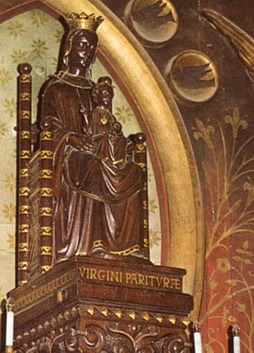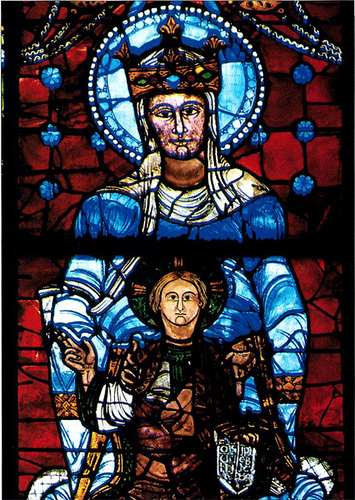Palm Sunday (Passion Sunday, Sunday before Easter)
Notre Dame, Chartres, Eure-et-Loir, Centre, France
On Palm Sunday weekend, thousands of students from the Paris area converge on the Cathedral of Notre Dame at Chartres. The pilgrimage goes back to 1911, when French author Charles Péguy promised to walk to Chartres on behalf of his son, who was sick with diphtheria. A devout but non-practicing Catholic married civilly to an atheist, Péguy made the pilgrimage on June 14, 1912. After the writer's death in 1914, some of his friends followed the same 50-mile trek in his memory. In 1935, a small group of Sorbonne students decided to walk to Chartres in Péguy's footsteps. The next year, the student pilgrimage was born, lasting three days, with 100 participants. Organized by the students themselves, the event grew throughout the following decades, even during the war, with some 4,000 pilgrims in 1945. But the turbulent 1960s took its toll, with many students, and even Vatican II, turning away from old religious traditions. The student pilgrimage dwindled away. But in the 1990s, it revived, playing a role in the Catholic World Youth Days held in Paris in 1997 and in the Jubilee celebrations of 2000. Some 3,000 students make the march, now organized by school chaplains and lasting only two days. Instead of walking the whole way, pilgrims gather for sendoff masses in their local churches (e.g. Notre Dame de Paris), then ride to starting points from which they walk 15 or 25 miles to Chartres. (See the official pilgrimage website, chartres.meci.org.) Another Paris-to-Chartres pilgrimage, that of Notre-Dame de Chrétienté, has taken place since 1983 on the weekend of Pentecost. Chartres celebrates its patronal feast at the Assumption, August 15.
About Notre Dame de Chartres
A strong if disputed tradition holds that before the coming of Christianity, when Chartres had the Roman name Carnoten, druids worshipped there at a shrine of Virgini Pariturae, the Childbearing Virgin.
 In the late 300s, Christians built the first
cathedral at Carnoten, over a holy well, le Puits des Saints Forts, in
which early martyrs were thrown. In 858, Vikings burned that first church
and added more saints to the well. Meanwhile, in 810, the Byzantine
Emperor and Empress sent Charlemagne two relics of the Blessed Virgin, her
robe and veil, which he enshrined at Aix-la-Chapelle.
In 876, his grandson Charles the Bald presented the veil to the bishop of
Chartres, giving the diocese some added pilgrim revenues to help with
rebuilding. But the second cathedral burned in 962 and the third in 1020.
Then St. Fulbert, Bishop of Chartres, began building the Romanesque
church, whose crypt remains under the Gothic edifice begun after the fire
of 1194 and consecrated October 24, 1260. This, the present Cathedral, a
masterpiece and landmark of Gothic architecture, the first to support
walls of stained glass with flying buttresses, imposes a profound
spiritual presence upon its millions of tourists. The Virgin's Veil is
still on display in the crypt, along with a 1976 replica of Notre-Dame-de-sous-Terre,
Our Lady of the Underground (left)—the old wooden Black Virgin from the
Romanesque Cathedral, the Virgini Pariturae, which revolutionaries burned
in 1793. This crypt was the site of a medieval Lourdes, where pilgrims
flocked for healing to the Well of Strong Saints. On the main level,
behind the choir, is another Black Virgin, Notre-Dame du Pilier, robed and
mounted on a pillar. Current scholarly sources agree (without saying what
might have happened to the original) that this pearwood statue dates to
the early 1500s and was a replica of a silver gilt statue made around
1220, which occupied a place of honor on an altar screen removed in 1763.
During the Revolution, Our Lady of the Underground was sacrificed to save
the present statue of Our Lady of the Pillar, which hid in the crypt,
moving back to the nave and onto the pillar in time for its solemn
coronation May 31, 1855. Another beloved image of the Virgin in
Chartres is the "blue window" of Notre-Dame de la Belle
Verrière in the south transept, Our Lady of the Beautiful Window (above),
from the Romanesque church.
In the late 300s, Christians built the first
cathedral at Carnoten, over a holy well, le Puits des Saints Forts, in
which early martyrs were thrown. In 858, Vikings burned that first church
and added more saints to the well. Meanwhile, in 810, the Byzantine
Emperor and Empress sent Charlemagne two relics of the Blessed Virgin, her
robe and veil, which he enshrined at Aix-la-Chapelle.
In 876, his grandson Charles the Bald presented the veil to the bishop of
Chartres, giving the diocese some added pilgrim revenues to help with
rebuilding. But the second cathedral burned in 962 and the third in 1020.
Then St. Fulbert, Bishop of Chartres, began building the Romanesque
church, whose crypt remains under the Gothic edifice begun after the fire
of 1194 and consecrated October 24, 1260. This, the present Cathedral, a
masterpiece and landmark of Gothic architecture, the first to support
walls of stained glass with flying buttresses, imposes a profound
spiritual presence upon its millions of tourists. The Virgin's Veil is
still on display in the crypt, along with a 1976 replica of Notre-Dame-de-sous-Terre,
Our Lady of the Underground (left)—the old wooden Black Virgin from the
Romanesque Cathedral, the Virgini Pariturae, which revolutionaries burned
in 1793. This crypt was the site of a medieval Lourdes, where pilgrims
flocked for healing to the Well of Strong Saints. On the main level,
behind the choir, is another Black Virgin, Notre-Dame du Pilier, robed and
mounted on a pillar. Current scholarly sources agree (without saying what
might have happened to the original) that this pearwood statue dates to
the early 1500s and was a replica of a silver gilt statue made around
1220, which occupied a place of honor on an altar screen removed in 1763.
During the Revolution, Our Lady of the Underground was sacrificed to save
the present statue of Our Lady of the Pillar, which hid in the crypt,
moving back to the nave and onto the pillar in time for its solemn
coronation May 31, 1855. Another beloved image of the Virgin in
Chartres is the "blue window" of Notre-Dame de la Belle
Verrière in the south transept, Our Lady of the Beautiful Window (above),
from the Romanesque church.
Sources include:
| The cathedral's website, www.cathedrale-chartres.org | |
| James Bugslag, "Pilgrimage to Chartres: The Visual Evidence," in Blick, Sarah, and Rita Tekippe, eds., Art and Architecture of Late Medieval Pilgrimage in Northern Europe and the British Isles, vol. 1, Leiden and Boston: Brill Academic Publishers, 2005. | |
| "Iconographie: les statues de Vierges noires en France," viergesnoires.marie-madeleine.com (photo of Notre-Dame-de-sous-Terre) | |
| "Notre Dame De La Belle Verriere," photo uploaded Nov. 17, 2005 by Merowig to www.flickr.com/photos/77615443@N00/64373660/ |
Also commemorated this date:
| Santa Maria della Tavella, Concordia Sagittaria, Venezia, Veneto, Italy (St. Mary of the Common Field). Procession. | |
| Santa Maria della Quercia, Rome, Italy (St. Mary of the Oak). Pasqua del macellaio feast prepared by butchers' confraternity. | |
| Santa Maria della Pietà, Scicli, Ragusa, Sicily, Italy. Street procession. | |
| Onze Lieve Vrouw ten Berg, Dokkum, Dongeradeel, Friesland, Netherlands (Our Lady of the Mountain). Former procession with statue around Premonstratensian priory of women, before it closed in 1580. | |
| María Santísima de la Amargura, Elche, Baix Vinalopó, Alicante, Valencia, Spain (St. Mary of Bitterness) | |
| Nuestra Señora de la Estrella, Jerez de la Frontera, Cádiz, Andalucia, Spain (Our Lady of the Star). Procession. | |
| Virgen de Lágrimas y Favores, Málaga, Andalucia, Spain (Virgin of Tears and Favors) | |
| María Santísima de los Dolores, Murcia, Murcia, Spain (St. Mary of Sorrows). Procession from Church of San Pedro. |
